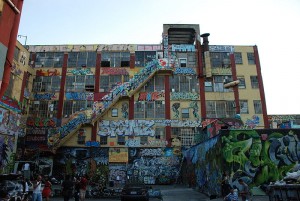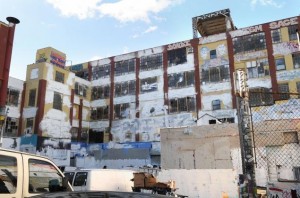Several street artists have sued the property owners of the building in Queens that became known as “5Pointz”—a “Mecca” of graffiti and street art. This is the second such lawsuit, after another group of artists failed to obtain a preliminary injunction in November, 2013, and the owners whitewashed nearly all of the painting on the buildings. The new lawsuit seeks damages related to the whitewashing itself, alleging that it was done hastily and secretly without giving the artists sufficient time either to remove or document their work. It relies on the Visual Artists Rights Act of 1990 (VARA), the lone moral rights provision of the Copyright Act.
Before:
After:
VARA protects primarily two things, and under certain conditions: the right of attribution and the right of integrity. The right of attribution says that an artist has a right to control when a work of visual art (as defined in the statute, more on that in a moment) can be attributed to him or her—even when he or she no longer owns the work: “the right to prevent the use of his or her name as the author of the work of visual art in the event of a distortion, mutilation, or other modification of the work which would be prejudicial to his or her honor or reputation.” A well known recent example of this was when Sotheby’s withdrew a work by artist Cady Nolan from auction because she said that it had been altered too much to still be considered her work (Sotheby’s then prevailed in a lawsuit by the consignor who was upset at the withdrawal from sale). Christoph Büchel’s lawsuit against MassMoCA was similar, in that the museum was not permitted to show his installation as by him after he left the project over creative differences. The right of attribution is available to any artist, regardless of fame or renown, but it is not at issue in the new case.
What is involved in both lawsuits is the right of integrity. § 106A(3)(B) of the Copyright Act (VARA) gives an artist the right "to prevent any destruction of a work of recognized stature, and any intentional or grossly negligent destruction of that work is a violation of that right." The statutory right relates to the work’s stature, not the artist’s.
Against all this, the new lawsuit argues on behalf of plaintiffs Maria Castillo (TOOFLY), James Cochran (Jimmy C), Luis Gomez (Ishmael), Bienbenido Guerra (FCEE), Richard Miller (Patch Whiskey), Kai Niederhausen (Semor), Carlo Nieva, Rodney Rodriguez (PANIC), and Kenji Takabayashi that:
Without giving Plaintiffs a fair opportunity to remove and preserve their work, or even the minimum notice required by law, Defendants suddenly decided to destroy it under cover of night, even though at the time of the destruction they were far from ready to demolish the buildings in question. The destruction was gratuitous, willful and wanton, and undertaken without regard to the feelings, reputations or financial interests of the Plaintiffs, who now seek compensation for their devastating losses.
Although the Complaint makes explicit reference to the artists’ recognized stature—which, as noted above, does not qualify for protection—I think the liberal pleading standard certainly allows an inference from the entire Complaint that the allegation is that the works were of recognized stature. Courts generally will not require the recitation of magic words right from the statute (nor will such a recitation be enough without more), and the Complaint discuss the fame of the works and of 5Pointz as a destination.
The case has already been assigned to the same judge that is presiding over the first one (which is still going on). So, the question is, what would be different this time? The first and important point is that the first plaintiffs did not lose, they just could not get an injunction to save the painting. And, the main thrust of this new case is damage related to the whitewashing of the graffiti.
Still, the availability of protection is a threshold requirement that will be a challenge given the ruling in the first case. There, the judge found that 5Pointz was not a “work of visual art,” but more of a tourist attraction, and that the plaintiffs did not meet their burden of irreparable harm. On the latter point, I was just last night watching the HBO special Banksy Does New York, which is terrific on the topic of Banksy specifically, but also has some moving video shots of 5Ppointz before its whitewashing. That’s not coming back, which seems like irreparable harm to me. I still don’t understand the “work of visual art” holding either, because the statute is pretty explicit about what is, and what is not, a “work of visual art” that gets VARA protection:
A “work of visual art” is—
(1) a painting, drawing, print, or sculpture, existing in a single copy, in a limited edition of 200 copies or fewer that are signed and consecutively numbered by the author, or, in the case of a sculpture, in multiple cast, carved, or fabricated sculptures of 200 or fewer that are consecutively numbered by the author and bear the signature or other identifying mark of the author; or
(2)a still photographic image produced for exhibition purposes only, existing in a single copy that is signed by the author, or in a limited edition of 200 copies or fewer that are signed and consecutively numbered by the author.
A work of visual art does not include—
(A) (i) any poster, map, globe, chart, technical drawing, diagram, model, applied art, motion picture or other audiovisual work, book, magazine, newspaper, periodical, data base, electronic information service, electronic publication, or similar publication;
(ii)any merchandising item or advertising, promotional, descriptive, covering, or packaging material or container;
(iii)any portion or part of any item described in clause (i) or (ii);
(B)any work made for hire; or
(C) any work not subject to copyright protection under this title.
These are paintings under that definition, from my perspective. Whether or not the judge is correct, however, he is the judge, and will presumably rule the same way in the second case, unless he views the newer claims as more particular to specific paintings and artists and less to 5Pointz as a whole. The good news for the plaintiffs is that the judge was quite interested in the question of recognized stature, though he never reached it in the injunction decision.
Lastly, this case will be very interesting to watch on the question of damages. Presumably none of the works were registered and entitled to statutory damages. So what is the measure of their financial loss? The defendants are not exploiting the works in a way that could result in profits to be turned over, they destroyed the graffiti. Is the damage to the artists’ reputations? How will that be quantified? One theme we discussed last week’s "Copyrights on the Street” panel in Newport was the idea of a loss of “street cred” as a measure of damages, but there too, that had more to do with unauthorized exploitation than financial loss.
This Complaint seems drafted for the long game. The plaintiffs’ attorneys obviously know the contours of the first ruling, and one has to think the expectation is ultimately to get to the Second Circuit and make some governing law. It would be helpful, because despite the uptick in recent graffiti art cases, most have still settled before any substantive litigation or findings took place.
In re-reading the original 5Pointz opinion, by the way, I noticed an interesting overstatement in the preamble:
This marks the first occasion that a court has had to determine whether the work of an exterior aerosol artist—given its general ephemeral nature—is worthy of any protection under the law.
That’s not quite right. Earlier that same year, the Ninth Circuit ruled on a copyright case in which the original work was street art. The question on review was whether the Green Day concert video that incorporated that image was a fair use (the court held that it was), but fair use analysis necessarily means that the work is copyrighted and any reproduction is otherwise an infringement. So a U.S. Court of Appeals had indeed already found that “the work of an exterior aerosol artist [] is worthy of [] protection under the law” by the time the 5Pointz injunction was denied.
More updates to come as developments warrant.





